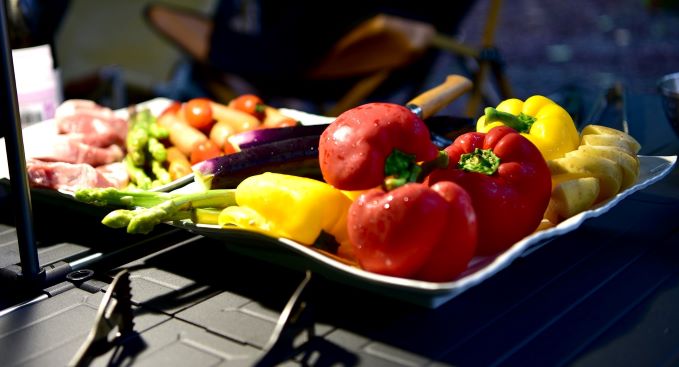This post contains affiliate links.
Last year I wasted so much food and money during our camping trips because I could not keep it fresh. I have changed how I food shop for our camping trips and tested different ways to purchase food. To reduce waste, save money and stop overloading my car when I do not need to.
Avoid food and money waste by buying main essentials and food for the first night and breakfast. Arrange for Click and Collect or delivery to the campsite the following day. Support local shops and purchase food for several days only to reduce waste. Reducing worry about keeping food fresh, increasing space when travelling and less to pack.
We are all guilty of overspending food and drink, especially when camping. We automatically assume that we cannot buy food while we are away. So we buy for every occasion. Often throwing food away or bringing it all back home and swearing that you will never do it again.
Family camping food saving: Increase space, save money and reduce stress

Preparing for a family camping trip can be a daunting task, especially when it comes to packing food. The limited space in your vehicle and the need to ensure freshness and convenience can quickly become overwhelming.
I dread packing my car for a long camping trip as it always feels like a jigsaw puzzle trying to fit everything in. Every small space is filled. I am often feeling stressed before we have even started our journey.
- Optimize food shopping – By purchasing your food during the camping trip, you can enjoy a wider range of fresh options. Consider visiting local food shops near your campsite for the essentials. This approach allows you to reduce the initial load and create space in your vehicle. It is a great way to support local businesses, and if you are camping on a farm, they will often sell everyday items, including fresh produce.
- Plan meals and shop for a few days – Plan your meals for the first few days of camping to ensure you have enough supplies. Check the weather forecast to tailor your meals to the conditions. Quick and easy meals are ideal for hot weather while comforting dishes are perfect for colder evenings. Shopping for a few days at a time helps avoid waste and saves money. Our article will help to keep food cold without worrying about spending money on a cool box if you have a limited budget.
- Combine shopping with day trips – To minimize trips and save fuel, plan your food trips with day trips or other activities near the campsite. This way, you can make the most of your time and resources.
- Avoid food waste and spoilage – By shopping in smaller quantities, you can prevent throwing away food that couldn’t be kept cool or fresh. No more wilted salads or defrosted burgers that are challenging to cook and can lead to food poisoning. This approach ensures that you use the purchased food before it spoils. It is also important to ensure that you have a cool box to reduce food from wasting. There are several types of cool boxes, passive, electrical, compressor and absorption cool boxes. Consider your camping style and most importantly safety and space. Not sure what is best?, read our article where we explain all safety aspects, how they work to help you make your choice.
I carried out a survey asking 70 people how they shopped for their camping holidays. 33% purchased food from the local shops near their campsites, and 30% arranged for deliveries to the campsite on the evening or the following day of arrival.
| Food Buying | Percentage |
|---|---|
| Click & Collect | 16% |
| Local shops or supermarkets | 33% |
| Delivery to campsite | 30% |
| Purchase food before a camping trip | 7% |
The 7% of the survey purchased food before their camping trip for different reasons.
- 3% – Their campsite was over 20 miles from a local store.
- 2% – Prepared meals before their holiday to reduce cooking whilst on holiday.
- 2% – Did not want to worry about food shopping whilst they were on holiday.
15% of campers did not worry about buying food for the first night. They arrange for takeaways, a great way to reduce stress and relax the first evening. Especially if you arrive at your campsite late and are tired from setting up camp.
To help reduce my stress levels and to be able to have space in my car when travelling, I only buy the main food essentials for our first night. Before any camping trip, I check the distance for any local food shops, so the day after arrival, I will go shopping, but only for a couple of days.
I plan meals for the first few days of camping. I don’t buy for more than a few days at a time because I consider the weather. As we are aware, UK weather is very unpredictable. I don’t want to spend ages cooking over a hot stove or BBQ if the weather is hot. I want something quick and easy. But if it is going to be cold, you want more comfort food during the evening.
Main food essentials for your camping trip
You are freeing space in your car by purchasing only the main essential items for the first night and breakfast. So no more worrying about how you will get everything in, as I often do.
83% of people confirmed the main essentials they purchase before their camping trip, and during their holiday, they shop the day after arrival locally.
- Picnic for the journey
- Snacks for children
- Food for an evening meal
- Food for breakfast
- Tea, coffee, milk
- Cold drinks
- Condiments
- Beer and wine
Campsite deliveries: Access, delivery time, and your presence
When planning to have groceries delivered to your campsite, it’s essential to consider various factors such as access to the site, delivery timing, and your presence during the delivery. This guide will provide insights to help you navigate the process smoothly.
- Campsite policy – Contact the campsite directly to confirm if they allow food deliveries before placing an order. Ensure they know your intentions and any potential delays due to traffic. It’s crucial to be considerate of fellow campers, especially as late deliveries may disrupt their peace, particularly if they have young children trying to settle for the night.
- Access restrictions – Different campsites may have varying access restrictions. Larger campsites with barrier access might not permit food delivery vans onto the premises. In such cases, you must arrange to meet the delivery driver at the main gates or designated meeting points.
- Ground conditions – Consider the ground conditions, especially during autumn or periods of rain. Wet or muddy terrain may pose challenges for delivery vans. Discuss this with the campsite management to avoid complications and consider alternative options.
- Potential limitations – One downside of campsite deliveries is the possibility of substituting unavailable items without notice. This can be frustrating, especially if a crucial item is missing. In such cases, you may need to travel to the store the next day to secure the missing items.
Considerations for car weight limits and safe loading
When packing for a camping trip, it’s important to be mindful of your car’s weight limit to ensure safe driving conditions. Additionally, the weight distribution of your luggage, including tents and extensions, should be carefully considered. Let’s explore the significance of car weight limits and the potential consequences of overloading your vehicle.
- Car weight limit -Check your car’s handbook to determine its weight load capacity, including passengers and luggage. Exceeding this limit can result in fines, penalty points, and insurance invalidation. While instances of being pulled over specifically for overloading are rare, erratic driving may attract police attention to the weight of your vehicle.
- Weight of tents and extensions – Consider the weight of your tent and any extensions, as they often comprise the heaviest items in your luggage. Although convenient, air tents tend to be heavier than fibreglass-poled tents. Adding an extension, gazebo, cooking facilities, chairs, tables, and other camping gear can significantly impact your car’s overall weight.
- Safety and handling – Overloading your car can have dangerous consequences, affecting its handling and braking capabilities. It can strain your car’s suspension and tires, compromising your safety and that of other road users. For every additional 100 lbs of weight, your fuel consumption may increase by 1-2%.
- Visibility requirements – Ensure your view is not obstructed while loading your car, especially the side and rear windows. While it’s not illegal to have limited visibility in good weather, you must have two side mirrors providing a full view. However, having any restricted view in your car windows is illegal during adverse weather conditions and can lead to fines.
If you exceed the weight limit of your car, you could face penalties under The Road Traffic Act 1988, including fines of up to £5000, penalty points on your license, and insurance invalidation.
While it’s uncommon for individuals to be pulled over specifically for overloading their car, if you drive erratically and attract police attention, they may inquire about the weight of your vehicle if it appears to be packed full.
When loading my car for camping trips, I prioritize checking that my view remains unobstructed in the side and rear windows, particularly when loading the back seats. Ensuring clear visibility is essential for my safety and the safety of other road users.
Why is it important to choose a lightweight camping stove?
The main essential of camping is having a means to cook. However, when choosing a stove it is essential to consider the space for transporting, fuel type, size and weight. These will impact the type of stove you buy.
I enjoy a BBQ or cooking over a firepit. Over the years of camping I have reduced my usage of a BBQ preferring to cook on a portable firepit, gas or electric stove.This is mainly due to convenience as I prefer to be exploring with my son, rather than waiting for coals to heat or lugging gas bottles with us. I have limited space in my car which is very retristing.
For convenience I have a single and double electric stove which is flat, lightweight however restricted to using EHU on site or my Jackery generator. The stove can easily be transported and does not take up a lot of space. My gas stove is single portable that has a carry gas as uses cannisters instead of bottle. Ihave several of these so I can leave one at home if we are on short trips.
I also have a Campingaz double gas stove, which requires bottled fuel rather than cannisters. This is for longer holidays. The fuel bottle is bulky to transport, however the stove it self is not. So I do need to consider the type of camping trip, length, location and also the tent we take. As some of our tents take up over 2/3s of my car boot.
When deciding on how to reduce wastage, save space when camping consider the type of style of cooking you will be doing. If you need quick instant fuel source or a slow burner such as a BBQ or firepit. It is no only your food that will take up valuable space in your car.
Suggested articles
Related questions
How to keep your food cool when camping
Keeping your food cooled is essential during camping trips to maintain freshness and prevent spoilage. With the right equipment and a strategic approach, you can ensure your food stays cool and safe to consume. Follow these tips to effectively manage your food’s temperature while camping.
- Portable cool boxes or bags – Invest in two good quality portable cool boxes or bags to store your food and drinks separately. This separation helps avoid frequent opening and exposure to warm air. Choose between an electrical coolbox or insulated cooler bags based on your preferences and available resources.
- Freezing ice blocks and bottles – Several days before your camping trip, freeze ice blocks that can be used to keep your food cool. Pack the ice blocks in layers, alternating with the food items in the cool box or bag. This arrangement helps maintain a consistent temperature inside. If you don’t have enough ice blocks, fill bottles with water and freeze them as substitutes. These frozen bottles work well for keeping food cold and can be refrozen when needed.
- Utilize campsite freezing facilities – Many campsites provide freezing facilities for ice blocks. Take advantage of this service to rotate and replenish your supply of ice blocks regularly. By doing so, you will always have a reserve of frozen blocks available for your cool box. Remember to label and secure your ice blocks in a bag when using communal freezers.
- Avoid ice bags – Avoid using ice bags from service stations or supermarkets, as the ice in these bags tends to melt quickly, leaving you with a puddle of water at the bottom of your cool box. This can create a messy situation, especially if food is stored in boxes.
Advantages of cooler bags over electrical coolboxes
Cooler bags offer several advantages over electrical coolboxes when keeping your food cool during trips. From their ease of use and cleaning to their portability and flexibility, cooler bags provide a practical solution for storing your food.
- Space-saving and travel convenience – Electrical cool boxes tend to be bulky, occupying significant space during travel. Cooler bags, however, are lightweight and foldable, making them easy to pack and store. You can even place them in your freezer before your trip to pre-cool them. This space-saving feature allows you to fold the bag away when not in use while still keeping the ice blocks inside.
- Easy cleaning and maintenance – Cooler bags are easier to clean than hard-shell coolboxes. You can turn them inside out, disinfect them, and effortlessly remove any crumbs or spills. In contrast, cleaning hard shell cool boxes, especially removing all crumbs, can be challenging.
- Portability and flexibility – Unlike electrical coolboxes, cooler bags offer greater portability. You can move them anywhere, ensuring they stay in the shade to maintain coolness. This flexibility is beneficial when camping, as you can easily carry the cooler bag on day trips or take it to the beach, where electrical coolboxes are impractical.
- Cooling efficiency – While electrical coolboxes can keep your food cool, they may lose their coolness quickly when opened and require access to electricity. When combined with ice blocks, cooler bags provide efficient cooling and insulation. Manufacturers may not recommend placing ice blocks directly inside electrical coolboxes, but many users find it helpful for enhanced cooling performance.


